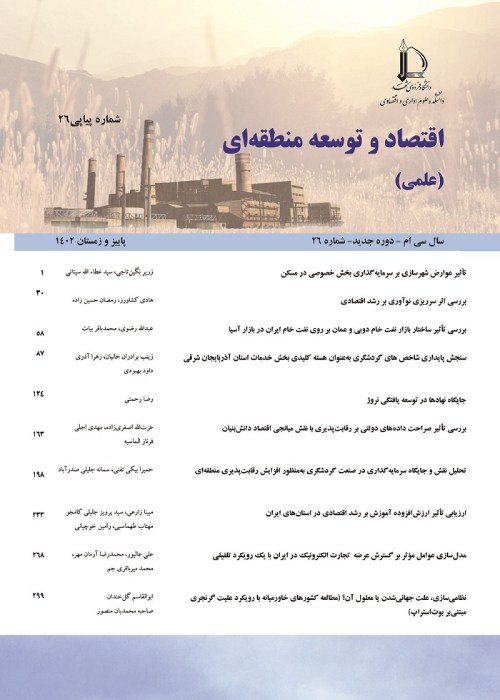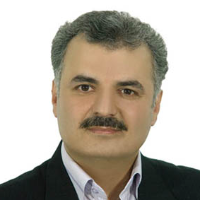Impact of Tax Structure on Income Poverty of the Selected Middle East and North Africa (MENA) Countries
Author(s):
Article Type:
Research/Original Article (دارای رتبه معتبر)
Abstract:
Extended abstract
1-
2- THEORETICAL FRAMEWORK
Poverty and income inequality the issue of poverty and poverty alleviation due to income inequality has always been the focus of economic planners and this feature of developing countries is one of the problems of human society that has not only not been controlled, but continuously despite the progress made in various economic fields intensified. Given the need to deal with the poverty crisis, this phenomenon should be studied and evaluated from both theoretical and practical aspects. Theoretically, poverty and its components should be carefully defined and identified, and from a practical point of view, the level of poverty in the country or society should be measured. The unbalanced distribution of income in society is one of the problems that in the short term, although it may not be reflected in the daily problems of the country, its continuation in the long run, in addition to creating widespread poverty, can create political tensions and lead to crises. Income redistribution can be achieved through tax policies, government transfer payments, and social spending.
3-
Gini = α +β1 INCT +β2 GT +β3 GDPP +β4 EDU +β5 UNEP +β6 INF +Uit
Where the introduced variables of the research model are:Gini: Gini coefficient
INCT: Income tax
GT: Tax on goods and services (consumption tax)
GDPP: Gross Domestic Product Per Capita
EDU: Number of people registered in the second stage of education
UNEP: Unemployment rate
INF: Inflation index rate
4- RESULTS &
5- CONCLUSIONS & SUGGESTIONS
According to the results, growth strategies must be considered along with income distribution. Establishing a strong tax system to prevent tax evasion as well as prevent illegal activities leads to the optimal size of government and the economy. If government interventions, if they are at their optimal level and social and educational programs are carried out to the extent that they improve social indicators, in addition to reducing the problems related to income inequality, reducing People's inclination and entry into the economy will have a great impact and will help to improve the situation and reduce income inequalities. In proportion to the results obtained, for taxes to play an effective role in income distribution, in addition to increasing the tax base, unnecessary tax exemptions should be avoided. For example, it is proposed to reduce the corporate tax rate and increase the wealth tax due to the transfer of the tax burden from the corporate tax.
1-
INTRODUCTION
The World Bank defines poverty as deprivation of the level of welfare and well-being. Inequality is defined as the difference between individuals in society in accessing economic resources that can appear in the distribution of income, wealth, consumption, wages, and savings of society. Equal distribution of income is always one of the most important issues in the economies of different countries and if we express the concept of poverty, and insufficient income, the challenge of more equitable distribution of income and wealth would be more important economic issues and is an important indicator of economic development which is considered by economic policymakers. At present, the existence of poverty and its severity in society is a sign of unhealthiness, poor economic system performance and failure of social justice programs and it is necessary to improve the situation of low-income people and below the poverty line appropriate monetary and fiscal policies affecting the improvement of the income distribution.2- THEORETICAL FRAMEWORK
Poverty and income inequality the issue of poverty and poverty alleviation due to income inequality has always been the focus of economic planners and this feature of developing countries is one of the problems of human society that has not only not been controlled, but continuously despite the progress made in various economic fields intensified. Given the need to deal with the poverty crisis, this phenomenon should be studied and evaluated from both theoretical and practical aspects. Theoretically, poverty and its components should be carefully defined and identified, and from a practical point of view, the level of poverty in the country or society should be measured. The unbalanced distribution of income in society is one of the problems that in the short term, although it may not be reflected in the daily problems of the country, its continuation in the long run, in addition to creating widespread poverty, can create political tensions and lead to crises. Income redistribution can be achieved through tax policies, government transfer payments, and social spending.
3-
METHODOLOGY
To examine and analyze the research hypotheses on the effect of tax structure on income inequality in a selection of the Middle East and North Africa (MENA) member countries including Iran, Egypt, Jordan, Turkey, Tunisia, Morocco, Cyprus, Rwanda, Zambia, Palestine. They are occupied and the data panel model for the years 2005-2018is used. The source of international data collection is the World Bank website and the International Indicators System. In this study, the Gini coefficient variable is used as an indicator of the income distribution, and the dependent variable is studied as an indicator of economic development in selected countries. Factors in the form of independent variables include the tax structure and other variables include economic factors such as inflation and per capita income. In this study, Gini coefficient variables have been used as an influential variable for the income inequality index. Following the existing theoretical foundations on the effect of tax structure on income inequality, the model of this research is specified as: Gini = α +β1 INCT +β2 GT +β3 GDPP +β4 EDU +β5 UNEP +β6 INF +Uit
Where the introduced variables of the research model are:Gini: Gini coefficient
INCT: Income tax
GT: Tax on goods and services (consumption tax)
GDPP: Gross Domestic Product Per Capita
EDU: Number of people registered in the second stage of education
UNEP: Unemployment rate
INF: Inflation index rate
4- RESULTS &
DISCUSSION
According to the research results, the effect of tax structure on income distribution, which in this study is examined by separating two types of taxes, one is goods and services tax and the other is the income tax. The results showed that rising inflation reduces income inequality. Although this result contradicts the common view of the relationship between inflation and income distribution, it can reinforce the part of economic theories that the existence of inflation in proportion to economic growth increases per capita income, which leads to improved distribution. Regarding the education variable, the results indicate that income inequality will decrease as government spending increases. Because labor wages are determined by their relative productivity, education can increase labor productivity by increasing literacy and knowledge levels and thus increase their wages, thereby helping to reduce inequality.5- CONCLUSIONS & SUGGESTIONS
According to the results, growth strategies must be considered along with income distribution. Establishing a strong tax system to prevent tax evasion as well as prevent illegal activities leads to the optimal size of government and the economy. If government interventions, if they are at their optimal level and social and educational programs are carried out to the extent that they improve social indicators, in addition to reducing the problems related to income inequality, reducing People's inclination and entry into the economy will have a great impact and will help to improve the situation and reduce income inequalities. In proportion to the results obtained, for taxes to play an effective role in income distribution, in addition to increasing the tax base, unnecessary tax exemptions should be avoided. For example, it is proposed to reduce the corporate tax rate and increase the wealth tax due to the transfer of the tax burden from the corporate tax.
Keywords:
Language:
Persian
Published:
Journal of Economy and Regional Development, Volume:28 Issue: 21, 2022
Pages:
203 to 238
https://magiran.com/p2510349
دانلود و مطالعه متن این مقاله با یکی از روشهای زیر امکان پذیر است:
اشتراک شخصی
با عضویت و پرداخت آنلاین حق اشتراک یکساله به مبلغ 1,390,000ريال میتوانید 70 عنوان مطلب دانلود کنید!
اشتراک سازمانی
به کتابخانه دانشگاه یا محل کار خود پیشنهاد کنید تا اشتراک سازمانی این پایگاه را برای دسترسی نامحدود همه کاربران به متن مطالب تهیه نمایند!
توجه!
- حق عضویت دریافتی صرف حمایت از نشریات عضو و نگهداری، تکمیل و توسعه مگیران میشود.
- پرداخت حق اشتراک و دانلود مقالات اجازه بازنشر آن در سایر رسانههای چاپی و دیجیتال را به کاربر نمیدهد.
In order to view content subscription is required
Personal subscription
Subscribe magiran.com for 70 € euros via PayPal and download 70 articles during a year.
Organization subscription
Please contact us to subscribe your university or library for unlimited access!



